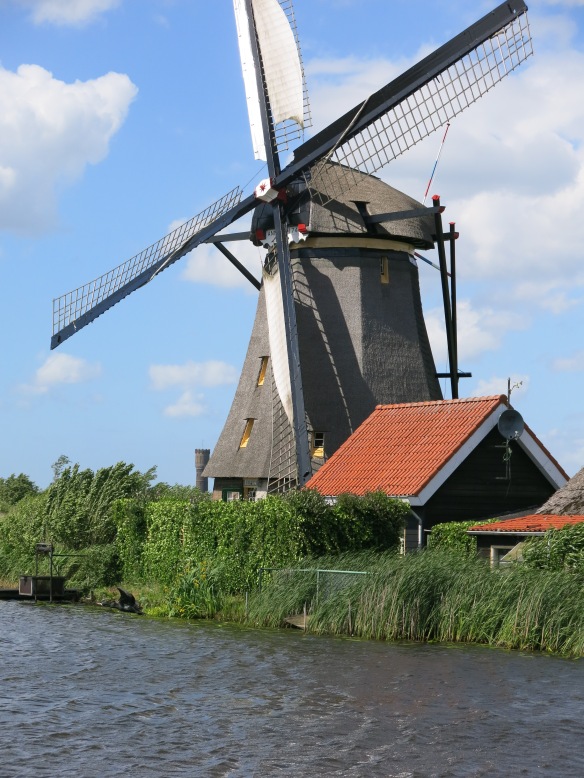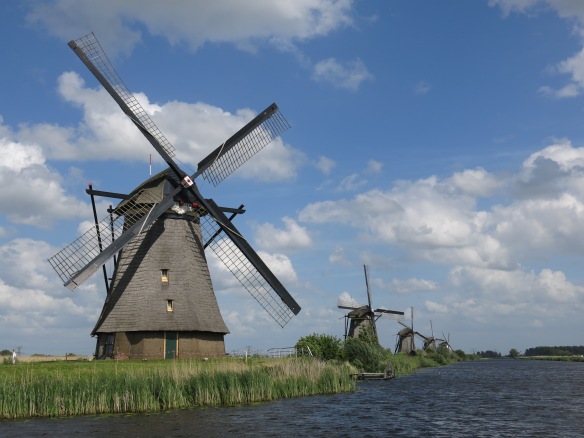Probably the most iconic Dutch symbol is the traditional windmill, or windmolen. As one travels about the Netherlands, there’s usually one, possibly two, windmills scattered in the landscape, isolated in the fields, but seldom are the great sails moving, as many are no longer operational. Sadly, there are only about a thousand or so windmolen left in the entire country. One source claims there about 1,150 windmills remaining, although the Dutch will only “count” a windmill if it is fully operational. Thus, to see several majestic windmills, sails rotating in the wind, such as these above at Kinderdijk, is a sight to warm a tourist’s campy heart.
The Kinderdijk is a small town situated on a piece of land jutting out among the polders and at the confluence of the Lek and Noord, about 7 miles east of Rotterdam in South Holland province. For those of you up on your Dutch, the name means (literally translated), “Children Dike” – more on the reason for this catchy moniker later. This water-sodden stretch of fields and marshes lying amidst the canals, dikes and rivers is called polders, or low-lying stretches of land (often below sea level), that are kept more or less usable by continual draining and controlling the amount of water entering the area. The polders themselves are of three types: marshes, reclaimed land (from both sea and river deltas) used for crops or grazing, and flood plains. The use of windmills to pump out excess groundwater, dikes, sluices, lockes and canals has been part of Dutch culture – and survival – for centuries. The nineteen remaining windmills of the Kinderdijk are actually still working windmills, although now modern technology does the lion’s share of pumping out water and land reclamation throughout the modern Netherlands. However, for centuries, the windmills played an important role in pumping from the polders into the canals overloads of ground water, flood waters, and in area nearest the North Sea, high tide water.

The polders, marshes and fields both, lying among the canals large and small, and their containing dikes.
The Dutch are famous for their centuries-long battle with the sea. There is a reason behind the adage: God created the world, but the Dutch created Holland. I’ve heard estimates that as much as half of modern-day Netherlands was once below sea-level and has since been reclaimed, although most on-line sources seem to think the actual amount is somewhere between 25-30%. However, a great deal of the “land” in Netherlands remains below sea-level, about 27%, kept dry and protected by a system of pumps sluices, canals and the thousands of dikes that contain and channel the water away from the workable, livable land.
This is, of course, a rather simplistic explanation of an intricate system and tug-of-war with the sea that the country has waged for hundreds of years. So far, the Netherlands seems to be winning, as it keeps adding reclaimed land bit by bit over the centuries. In 1986 a whole brand new, 12th province was proclaimed, Flevoland, from what had once been an inland sea. (More on this in a later blog.)
But back to the Kinderdijk. Yes, it’s a tourist attraction, these 19 windmills, sails a-turning, lining the canals, pumping out their share of groundwater. Yet as touristy as they are, the Kinderdijk is also a recreational area, drawing many hikers and bikers to the miles of paths topping the hundreds of dikes in this great polder.
Being ultimate tourists, we opted for a half-hour canal boat ride in order to gawk and snap pictures at a closer range. Accompanied by Michael’s brother David and his wife Joyce, who’ve been visiting us from Wisconsin, we all hopped on the next boat and cast off.
A few things I noticed immediately as we drew closer to the windmills was their shape – octagonal – whereas they’d seemed a roundish cone shape from a distance; that the majority of the sails (the four long arms that turn in the wind) didn’t have “sail cloth” in them; and, that the mills were thatched.

Another windmill with two sails unfurled. Notice the house and arbor next to it. Several of the windmills have people living in and/or next to them.
What I found out, in brief, is the following:
- The traditional Dutch windmill is a “smock mill,” a later variation of mill that has developed over the years from “tower” mills, to “post” and “hollow-post” mills. Essentially, they’re upright vertical structures with the sails attached near the top face of the mill.
- The “smock” mill is so-named because it usually has an octagonal structure, usually made of a wooden frame and “smocked” or covered with thatching, boards, canvas, or other materials.
- The “sails” are actually the framework for the arms of the windmill that turn in the wind and generate power – in this case, to pump water out of the fields. Other functions of windmills have been to turn millstones to grind grain, to operate saws, etc.
- All the Dutch windmills sails have cloth material or wooden slats that can be spread open or shut, depending on the strength of the wind as well as how much power is needed from the wind on a given day. This particular day was quite windy so most of the sails didn’t have their cloth or wooden slats spread out. Only a couple of windmills had the sails partly spread on them.
- Spreading the cloth or slats still means you have to stop the mill, and manually spread the cloth or unfold the slats. However, I believe now a hydraulic ladder is used, somewhat like a “cherry picker,” to hoist the mill operator up to reach the higher portions of the sails. I spied one folded up next to a mill, but didn’t get a good picture.
As I said, a shortened edition of history.
I also found out that many of these mills are occupied. Michael asked the boatman, who said that it was possible to rent the windmills. Looking at mills and at their detached houses showed an interesting mix of 18th and 21st centuries. And pictures always speak a thousand words:

Anyone spot the anachronistic intrusion in this “typical” Dutch portrait? (Yup, that’s a satellite dish mounted on the apex of the house’s roof!)

One last photo: “romantic landscape.” Actually, what Michael is saying is, “Carol, we have GOT to live in one of these windmills!” and I’m saying, “And YOU have GOT to be kidding!”
Couldn’t resist adding a bit of Dutch nationalism as a final picture.









